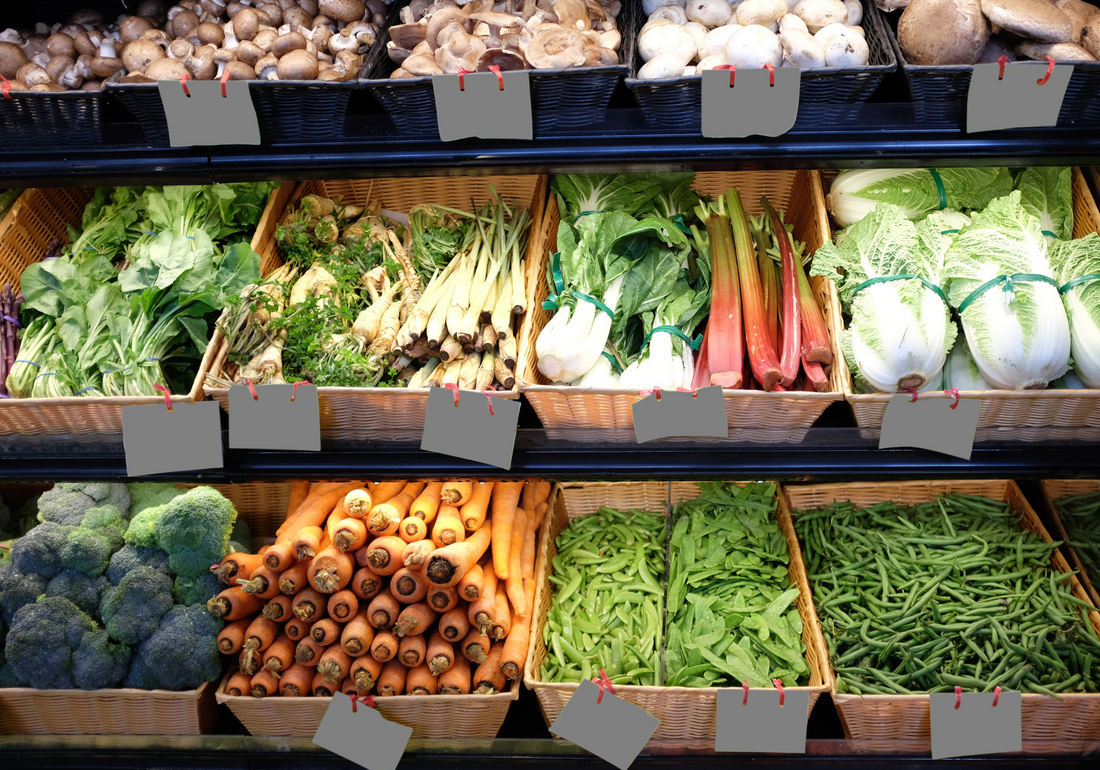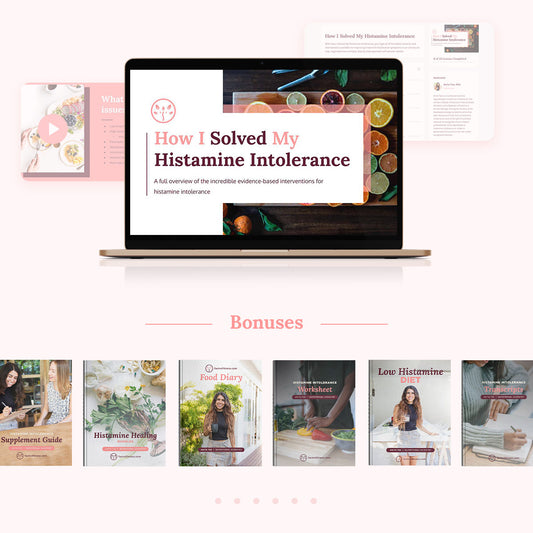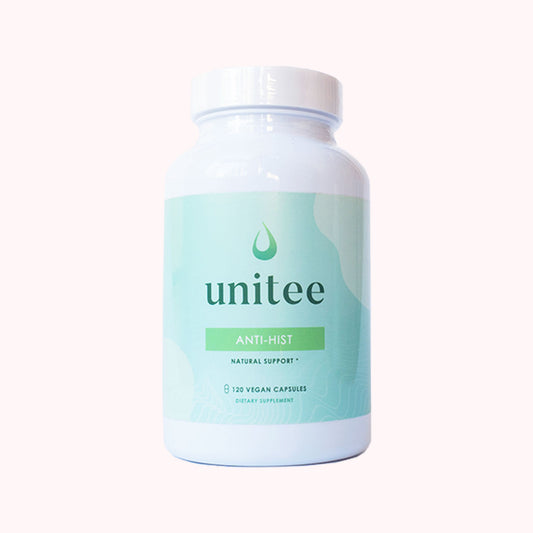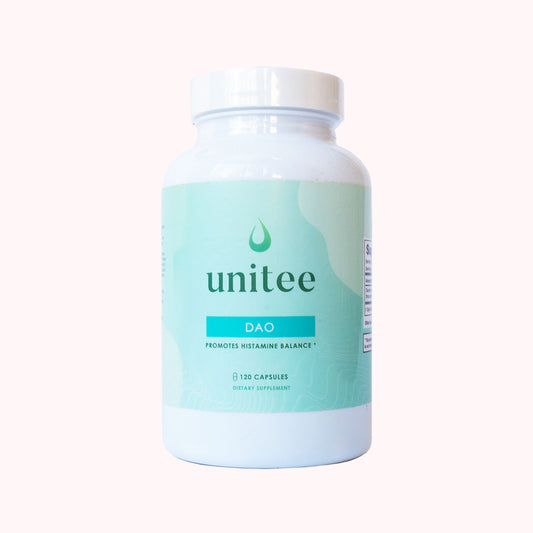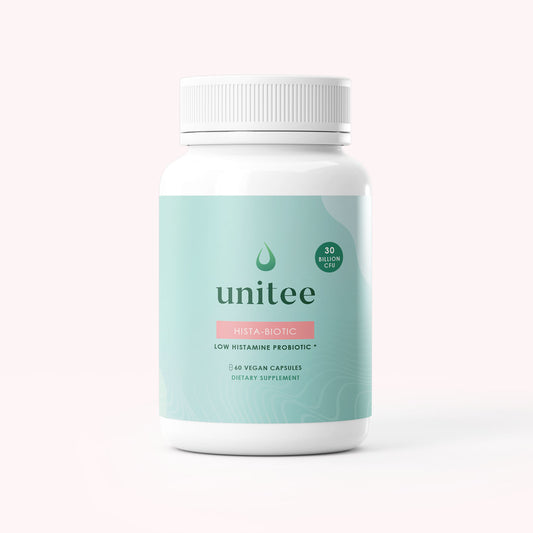What if antihistamine foods could change your body and improve your symptoms for good?
What if an antihistamine diet could improve your digestion, your skin, change your sleeping patterns, eliminate pain, possibly even aid in weight regulation and, improve overall health?
If your current all-natural diet doesn't seem to be controlling your symptoms, let's talk about how histamine can be the missing link between you and living your best life.
What is histamine intolerance?
Histamine is a word that’s been getting an awful lot of hype lately, which can lead you to believe that histamine, and an antihistamine diet are ‘trendy’.
Many diets that have become popularized in recent years, such as the Paleo, ketogenic and vegan diets, which are extremely high in histamine-rich and histamine-releasing foods (fermented foods, dairy, soy, etc.) (1). Even common gut healing diets incorporate these high histamine foods, which are great for your body - if you can tolerate histamine.
Often, those who are unknowingly histamine intolerant will follow these healing diets, yet won't see any symptom improvement - or, even end up pounding back kombucha and bone broth in search of relief, only to experience their symptoms becoming worse!
Additionally, for those with inflammatory or autoimmune conditions, histamine-rich diets may cause an influx of health problems surrounding inflammation. These consequences may lead many to believe that all-natural or gut-health diets are actually unhealthy - when, in fact, there may simply be an overwhelming amount of histamine entering the body (1,2).
You see, a lot of these commonly considered healthy foods such as fermented foods like kombucha and kimchi, as well as even things like tomatoes, spinach and a variety of veggies are actually very high in histamine.
That's really not to say they're unhealthy in any way. They are super healthy. They just simply contain a certain compound (histamine) that, right now, your body isn't dealing with so well.
So, let's talk more about histamine.
What exactly is histamine?
To briefly review, histamine is a chemical that’s produced by your body to signal an alarm that invaders (ie. bacteria, infection, allergen, etc.) are present. This signal causes the body to put up its defences (hello, immune system!) in order to keep the invaders from - well, invading (3)!
This process is all well and good if your immune system is working properly, and your body is healthy.
However, this system can easily be thrown out of whack due to histamine intolerance - which causes internal histamine levels to be too high – meaning, these defences are up all the time, even when invaders are not present (4).
Many causes of histamine intolerance have been established in research. These underlying causes may include digestive issues such as leaky gut or IBS, bacterial issues such as small intestinal bacterial overgrowth (SIBO) or, issues with histamine release and degradation (2,5,7). Regardless of the cause, histamine intolerance can be a massive disruption to your health (5-7).
Symptoms, such as anxiety, digestive disturbances, hormonal imbalances, acne and other skin irritations (psoriasis, hives and eczema), brain fog, PMS, migraines, fatigue, and more are all commonly reported from those with histamine intolerance (2,5).
Keep in mind, histamine intolerance is not the same as a food allergy, which is why allergy testing may show that everything is A-okay, when clearly it's not (7)!
The lack of efficacy of these popular diets for histamine intolerant individuals is exactly why histamine is getting increasing attention. Because, in reality, there is an overwhelming amount of scientific evidence to back these gut-healing diets - they may simply need to be modified, for some individuals, to be a little lighter on the histamine.
So, how can we do this?
Reduce histamine levels with antihistamine foods
Eating a low histamine diet is the first step to reducing inflammation in the body. I've detailed exactly what foods to eat and avoid in my histamine intolerance foods list. If you haven't gotten a kick-start on this, click below to download my free histamine intolerance food list eBook!
In addition to following a low histamine diet, you can go a step further and, not only reduce incoming histamine - but, actually consume antihistamine foods that will combat high histamine levels in the body.
Let me explain.....
Low histamine foods are exactly that: foods which do not have high levels of histamine. This way of eating helps to keep histamine levels lower in the body by limiting the amount of histamine you ingest, so that your body is less flooded with this compound if you have a histamine intolerance.
Antihistamine foods, on the other hand, are ones that prevent the release of histamine or, help to degrade histamine in the body. Antihistamine foods take a low histamine diet to another level, as you are not only reducing the amount of histamine consumed - but, you are actually reducing the amount of histamine that is existing or released in the body.
Let me show you exactly how you can use an antihistamine diet for your histamine symptoms, too!
The antihistamine diet
As mentioned, an antihistamine diet consists of antihistamine foods, as well as avoidance of histamine-rich foods, histamine-releasing foods and foods which block DAO enzymes (the enzymes responsible for the breakdown of histamine in the body) (2,8).
Adopting an antihistamine diet can promote optimal health, reduce inflammation, help counteract SIBO and bacterial imbalances, all while supporting overall gut healing (5).
Remember, it's super important to aim for diversity in the foods you eat. Eating too narrow a spectrum of foods can cause nutritional deficiencies, so it's best to try to incorporate as many low histamine and antihistamine foods as possible into your diet.
You can start slow if you're unsure what to eat. For example, you might choose to eat a handful of foods you know you can tolerate and add in one new low histamine food or antihistamine food at a time to ensure the new food is compatible.
There are several well-known culprits that, although can be low in histamine are still often not well tolerated by individuals. These culprits include gluten and a variety of dairy, as common examples.
If you're particularly sensitive, it's best to start with more neutral foods like low histamine or antihistamine fruits, vegetables and proteins before moving onto any gluten or dairy containing products.
Overall, although starting an antihistamine diet can feel a bit overwhelming at first, the antihistamine foods listed below can help to reduce inflammation and could be the secret to unlocking your optimal health and wellness, especially for those with other pre-existing conditions and symptoms (3).
Antihistamine Diet: Foods to Avoid
**for a more comprehensive list of foods to avoid, check out my low histamine diet
In addition to high histamine foods, some of the foods below may not be high in histamine themselves, but, promote the release of histamine, block diamine oxidase (DAO) - an enzyme responsible for degrading excess histamine - or, destabilize mast cells to cause excess histamine release within the body. These foods should all be avoided.
| High Histamine Foods (click for comprehensive list) |
|
| Histamine-Releasing Foods |
|
| DAO Blocking Foods |
|
| Foods that Destabilize Mast Cells |
|
*(1,2,5,7)
As mentioned above, although some of these foods are typical “gut health-promoting” foods, due to high histamine levels, or histamine-releasing properties, they should definitely be avoided.
An antihistamine diet is not about “healthy” vs “unhealthy” foods, like most healing diets are. Instead, it’s about pinpointing which foods promote healing and anti-inflammatory responses in the body, and which foods provoke an immune response (1,2).
By far, one of the easiest ways to cut down on histamine is to buy fresh, whole foods. The longer your foods sit, age, ferment and cure, the more histamine is produced, hence why fresh is best (1,2).
But, keep in mind, although eating fresh will reduce overall histamine levels, this strategy alone is not effective enough for those with histamine intolerance, who cannot tolerate levels in many fresh foods, such as spinach and tomatoes.
The bottom line is that some people may still be getting a bad reaction from all-natural, healthy foods - and, until the underlying issue is sorted, these foods need to be eliminated.
Lastly, remember that it's not all about food. Many medications on the market have been found to block DAO enzymes. Common examples include Aspirin, Ciproflaxin, Diazepam (Valium), Metoclopramide (Reglan), Naproxen (Aleve), Prilocaine and Verapamil (7). These should also be avoided when possible - however, do not stop or change your current medication routine without discussing with your healthcare professional first.
Now, let's get to the good stuff - antihistamine foods you can indulge in on the antihistamine diet.
Antihistamine Diet: Foods to Include
Below is a list of antihistamine foods. Additionally, adding in supplements to support the removal of histamine from your body can also be extremely beneficial in reducing histamine-associated symptoms (5). Check out this list of the 7 best supplements for histamine intolerance.
| Antihistamine Foods |
|
| Neutral Foods (Safe if Tolerable) |
|
| Antihistamine Supplements |
*(1,2,5,7)
Because eating fresh is so important, focusing on buying fresh ingredients, making your own food and limiting leftovers is key in reducing histamine consumption (1,2).
Although dairy, nuts and seeds, and alcohol are all culprits for histamine, these items can sometimes be added back in. Dairy, nuts and seeds should be fully eliminated for at least two weeks, and slowly added back in, separately, in order to see if there is any kind of reaction (4).
When it comes to nuts, macadamia nuts tend to be the least problematic for those with histamine intolerance, so I do recommend starting with these!
Alcohol, on the other hand, should only be added in when necessary, and should be clear and low carbohydrate/sugar (vodka, white rum and gin) (9). You can also check my low histamine wine list where I detail specific types and brands of wine that tend to be lower in histamine.
Low histamine and antihistamine diets: listen to your body
As of 2018, experts suggest that at least 1% of the population suffers from histamine intolerance, 80% of which are middle-aged women (10). Additionally, those with digestive symptoms are especially susceptible.
This staggering figure suggests that a diet shift from histamine-rich foods to antihistamine foods, especially for women, could prove to be a severely underrated health promoting lifestyle change. As always, it is recommended to discuss any and all dietary and lifestyle changes with your healthcare practitioner.
Listening to your body, keeping a food and symptom diary and taking notice of any changes after eating is an excellent way to monitor any foods, medications, supplements and lifestyle products that may or may not be irritating you.
I provide plenty of tips for dietary success, as well as a free food and symptom diary as part of my free low histamine diet guide. I do recommend to get this free guide if you are starting on your low histamine journey, as you will have all of the best resources delivered straight to your email inbox.
Lastly, focusing on moderate exercise, staying hydrated, getting adequate sleep and managing your stress are also extremely helpful for any person, especially when making dietary and lifestyle changes.
For a more comprehensive program that incorporates all dietary, lifestyle, supplement and testing options, as well as a full overview of histamine intolerance, you can also have a look at the How I Solved My Histamine Intolerance course, which is a 10 module, step-by-step program detailing exactly how to solve histamine intolerance, naturally.
References
1. Ede G. Histamine Intolerance: why freshness matters. J Evol Heal. 2017;2(1):11.
2. Maintz L, Novak N. Histamine and histamine intolerance. Am J Clin Nutr. 2007;85(5):1185–96.
3. Balch PA. Prescription for Nutritional Healing. 4th ed. Avery, editor. London: Penguin Group; 2006. 980 p.
4. Haas EM, Levin B. Staying Healthy with Nutrition. Berkeley, CA: Celestial Arts; 2006. 925 p.
5. Myers A. Everything You Need To Know About Histamine Intolerance. 2013 [cited 2018 Oct 24].
6. Hoffman BD. What is Mast Cell Activation Syndrome ? Hoffman Centre for Integrative and Functional Medicine. 2017.
7. Burkhart A. Histamine Intolerance: Could it be causing your symptoms?. Integrative Medicine - Digestive Health. 2014 [cited 2018 Oct 24].
8. Myers AM. The Autoimmune Solution: Prevent and Reverse the Full Spectrum of Inflammatory Symptoms and Diseases. Harper Collins; 2017. 400 p.
9. Kohn JB. Is There a Diet for Histamine Intolerance? J Acad Nutr Diet. Academy of Nutrition and Dietetics; 2014;114(11):1860.
10. Boldt E. Does Histamine Intolerance Cause Allergies , Headaches & Bloating ? What is Histamine Intolerance ? [cited 2018 Oct 24].

Anita Tee
My name is Anita Tee. I'm a nutritional scientist who specializes in histamine intolerance. I hold a Master of Science in Personalized Nutrition and a Bachelor of Science in Human Biology and Psychology.For the past ten years, I have used my experience in nutritional and medical health sciences to create a scientifically backed, natural approach to healthcare that relies 100% on evidence-based research.As I previously suffered from - and overcame - histamine intolerance, my focus is to increase recognition and expand the available resources and protocols available for resolving this particular disorder. To date, I have helped over 4,000 individuals fully resolve or better manage their histamine intolerance symptoms.

